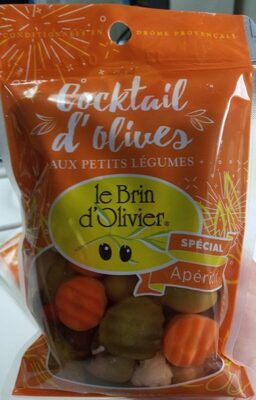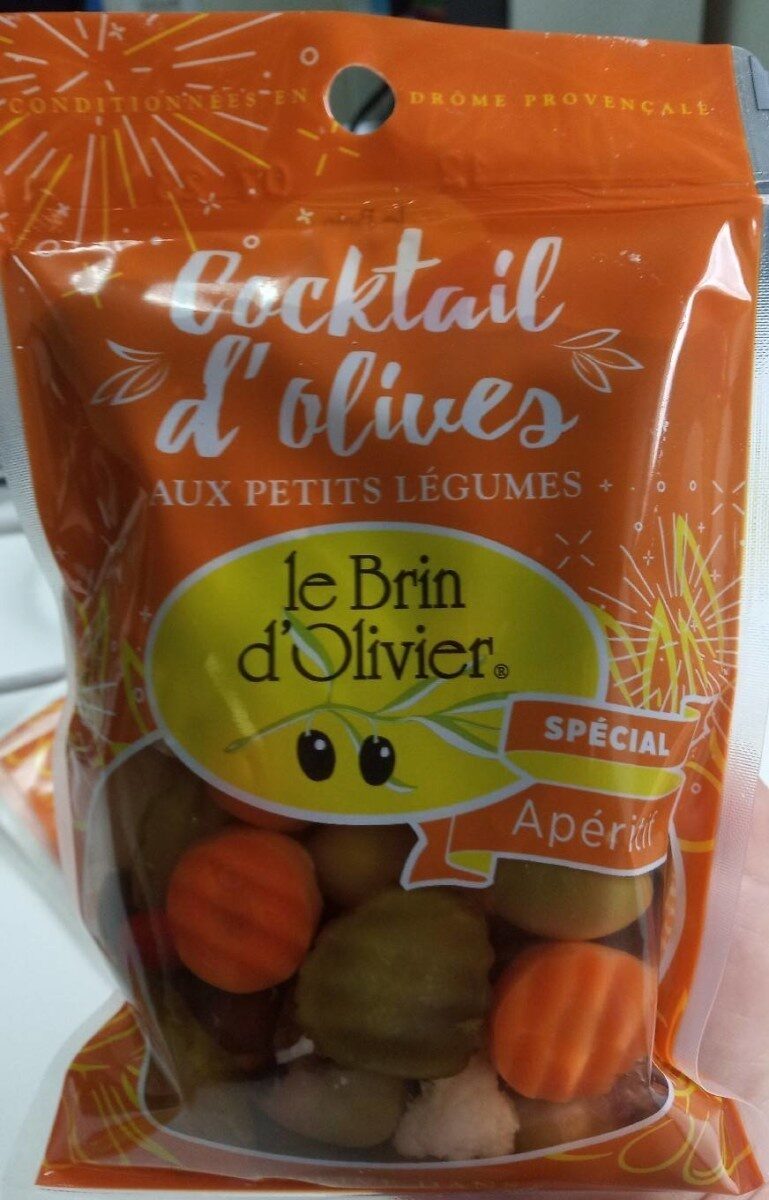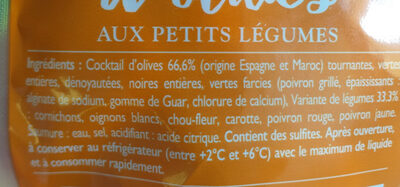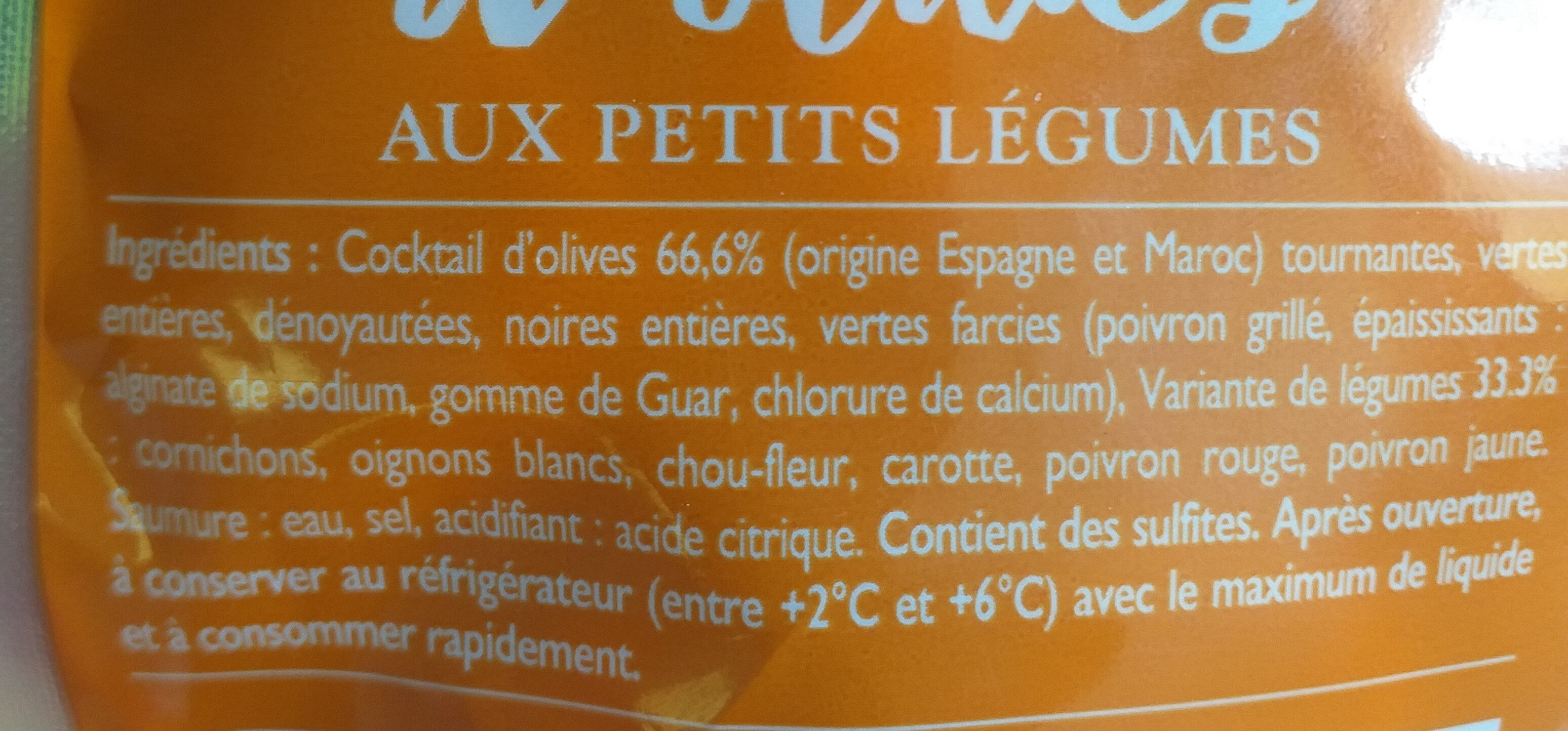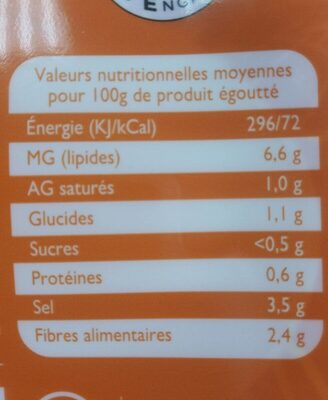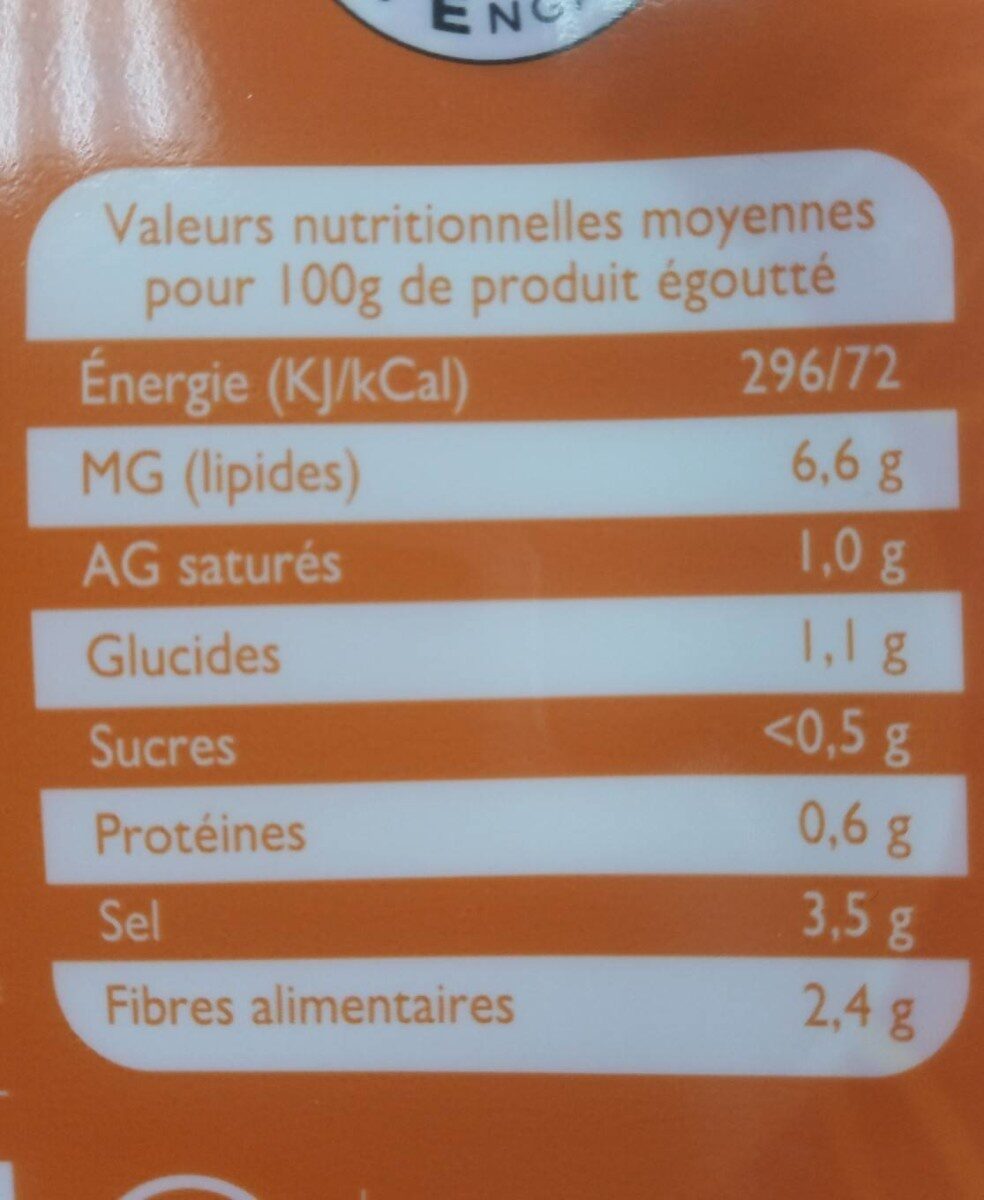Help us make food transparency the norm!
As a non-profit organization, we depend on your donations to continue informing consumers around the world about what they eat.
The food revolution starts with you!
Cocktail d'olives aux petits légumes - Le Brin d'Olivier - 230 g
Cocktail d'olives aux petits légumes - Le Brin d'Olivier - 230 g
This product page is not complete. You can help to complete it by editing it and adding more data from the photos we have, or by taking more photos using the app for Android or iPhone/iPad. Thank you!
×
Barcode: 3262880100042 (EAN / EAN-13)
Quantity: 230 g
Packaging: Plastic
Brands: Le Brin d'Olivier
Categories: Plant-based foods and beverages, Plant-based foods, Pickles, Olive tree products, Plant-based pickles, Olives, Green olives, Green olives in brine
Origin of ingredients: Spain, Morocco
Countries where sold: France
Matching with your preferences
Health
Ingredients
-
22 ingredients
: Cocktail d'olives 66,6% (origine Espagne et Maroc) tournantes, vertes entières, dénoyautées, noires entières, vertes farcies (poivron grillé, épaississants alginate de sodium, gomme de Guar, chlorure de calcium), Variante de légumes 33.3% cornichons, oignons blancs, chou-fleur, carotte, poivron rouge, poivron jaune. saumure: eau, sel, acidifiant: acide citriqueAllergens: Sulphur dioxide and sulphites
Food processing
-
Ultra processed foods
Elements that indicate the product is in the 4 - Ultra processed food and drink products group:
- Additive: E401 - Sodium alginate
- Additive: E412 - Guar gum
- Ingredient: Thickener
Food products are classified into 4 groups according to their degree of processing:
- Unprocessed or minimally processed foods
- Processed culinary ingredients
- Processed foods
- Ultra processed foods
The determination of the group is based on the category of the product and on the ingredients it contains.
Additives
-
E330 - Citric acid
Citric acid is a natural organic acid found in citrus fruits such as lemons, oranges, and limes.
It is widely used in the food industry as a flavor enhancer, acidulant, and preservative due to its tart and refreshing taste.
Citric acid is safe for consumption when used in moderation and is considered a generally recognized as safe (GRAS) food additive by regulatory agencies worldwide.
-
E412 - Guar gum
Guar gum (E412) is a natural food additive derived from guar beans.
This white, odorless powder is valued for its remarkable thickening and stabilizing properties, making it a common ingredient in various food products, including sauces, dressings, and ice creams.
When used in moderation, guar gum is considered safe for consumption, with no known adverse health effects.
-
E509 - Calcium chloride
Calcium chloride: Calcium chloride is an inorganic compound, a salt with the chemical formula CaCl2. It is a colorless crystalline solid at room temperature, highly soluble in water. Calcium chloride is commonly encountered as a hydrated solid with generic formula CaCl2-H2O-x, where x = 0, 1, 2, 4, and 6. These compounds are mainly used for de-icing and dust control. Because the anhydrous salt is hygroscopic, it is used as a desiccant.Source: Wikipedia
Ingredients analysis
-
Palm oil content unknown
Unrecognized ingredients: fr:cocktail-d-olives, fr:tournantes, fr:vertes-entieres, fr:denoyautees, fr:noires-entieres, fr:vertes-farcies, fr:variante-de-legumes-33-3-cornichonsSome ingredients could not be recognized.
We need your help!
You can help us recognize more ingredients and better analyze the list of ingredients for this product and others:
- Edit this product page to correct spelling mistakes in the ingredients list, and/or to remove ingredients in other languages and sentences that are not related to the ingredients.
- Add new entries, synonyms or translations to our multilingual lists of ingredients, ingredient processing methods, and labels.
If you would like to help, join the #ingredients channel on our Slack discussion space and/or learn about ingredients analysis on our wiki. Thank you!
-
Vegan status unknown
Unrecognized ingredients: fr:cocktail-d-olives, fr:tournantes, fr:vertes-entieres, fr:denoyautees, fr:noires-entieres, fr:vertes-farcies, fr:variante-de-legumes-33-3-cornichons, BrineSome ingredients could not be recognized.
We need your help!
You can help us recognize more ingredients and better analyze the list of ingredients for this product and others:
- Edit this product page to correct spelling mistakes in the ingredients list, and/or to remove ingredients in other languages and sentences that are not related to the ingredients.
- Add new entries, synonyms or translations to our multilingual lists of ingredients, ingredient processing methods, and labels.
If you would like to help, join the #ingredients channel on our Slack discussion space and/or learn about ingredients analysis on our wiki. Thank you!
-
Vegetarian status unknown
Unrecognized ingredients: fr:cocktail-d-olives, fr:tournantes, fr:vertes-entieres, fr:denoyautees, fr:noires-entieres, fr:vertes-farcies, fr:variante-de-legumes-33-3-cornichons, BrineSome ingredients could not be recognized.
We need your help!
You can help us recognize more ingredients and better analyze the list of ingredients for this product and others:
- Edit this product page to correct spelling mistakes in the ingredients list, and/or to remove ingredients in other languages and sentences that are not related to the ingredients.
- Add new entries, synonyms or translations to our multilingual lists of ingredients, ingredient processing methods, and labels.
If you would like to help, join the #ingredients channel on our Slack discussion space and/or learn about ingredients analysis on our wiki. Thank you!
-
Details of the analysis of the ingredients
We need your help!
Some ingredients could not be recognized.
We need your help!
You can help us recognize more ingredients and better analyze the list of ingredients for this product and others:
- Edit this product page to correct spelling mistakes in the ingredients list, and/or to remove ingredients in other languages and sentences that are not related to the ingredients.
- Add new entries, synonyms or translations to our multilingual lists of ingredients, ingredient processing methods, and labels.
If you would like to help, join the #ingredients channel on our Slack discussion space and/or learn about ingredients analysis on our wiki. Thank you!
: Cocktail d'olives 66.6%, tournantes, vertes entières, dénoyautées, noires entières, vertes farcies (poivron, épaississants (alginate de sodium), gomme de Guar, chlorure de calcium), Variante de légumes 33.3% cornichons, oignons blancs, chou-fleur, carotte, poivron rouge, poivron jaune, saumure (eau), sel, acidifiant (acide citrique)- Cocktail d'olives -> fr:cocktail-d-olives - percent_min: 66.6 - percent: 66.6 - percent_max: 66.6
- tournantes -> fr:tournantes - percent_min: 2.38571428571429 - percent_max: 33.4
- vertes entières -> fr:vertes-entieres - percent_min: 0 - percent_max: 31.0142857142857
- dénoyautées -> fr:denoyautees - percent_min: 0 - percent_max: 15.5071428571429
- noires entières -> fr:noires-entieres - percent_min: 0 - percent_max: 10.3380952380952
- vertes farcies -> fr:vertes-farcies - percent_min: 0 - percent_max: 7.75357142857143
- poivron -> en:bell-pepper - vegan: yes - vegetarian: yes - ciqual_food_code: 20041 - percent_min: 0 - percent_max: 7.75357142857143
- épaississants -> en:thickener - percent_min: 0 - percent_max: 3.87678571428571
- alginate de sodium -> en:e401 - vegan: yes - vegetarian: yes - percent_min: 0 - percent_max: 3.87678571428571
- gomme de Guar -> en:e412 - vegan: yes - vegetarian: yes - percent_min: 0 - percent_max: 2.58452380952381
- chlorure de calcium -> en:e509 - vegan: yes - vegetarian: yes - percent_min: 0 - percent_max: 1.93839285714286
- Variante de légumes 33.3% cornichons -> fr:variante-de-legumes-33-3-cornichons - percent_min: 0 - percent_max: 6.20285714285714
- oignons blancs -> en:small-white-onions - vegan: yes - vegetarian: yes - ciqual_food_code: 20034 - percent_min: 0 - percent_max: 5.16904761904762
- chou-fleur -> en:cauliflower - vegan: yes - vegetarian: yes - ciqual_food_code: 20016 - percent_min: 0 - percent_max: 4.43061224489796
- carotte -> en:carrot - vegan: yes - vegetarian: yes - ciqual_food_code: 20009 - percent_min: 0 - percent_max: 3.87678571428571
- poivron rouge -> en:red-bell-pepper - vegan: yes - vegetarian: yes - ciqual_food_code: 20087 - percent_min: 0 - percent_max: 3.44603174603175
- poivron jaune -> en:yellow-bell-pepper - vegan: yes - vegetarian: yes - ciqual_food_code: 20168 - percent_min: 0 - percent_max: 3.10142857142857
- saumure -> en:brine - percent_min: 0 - percent_max: 2.81948051948052
- eau -> en:water - vegan: yes - vegetarian: yes - ciqual_food_code: 18066 - percent_min: 0 - percent_max: 2.81948051948052
- sel -> en:salt - vegan: yes - vegetarian: yes - ciqual_food_code: 11058 - percent_min: 0 - percent_max: 2.58452380952381
- acidifiant -> en:acid - percent_min: 0 - percent_max: 2.38571428571429
- acide citrique -> en:e330 - vegan: yes - vegetarian: yes - percent_min: 0 - percent_max: 2.38571428571429
Nutrition
-
Average nutritional quality
⚠ ️Warning: the amount of fruits, vegetables and nuts is not specified on the label, it was estimated from the list of ingredients: 0This product is not considered a beverage for the calculation of the Nutri-Score.
Positive points: 2
- Proteins: 0 / 5 (value: 0.6, rounded value: 0.6)
- Fiber: 2 / 5 (value: 2.4, rounded value: 2.4)
- Fruits, vegetables, nuts, and colza/walnut/olive oils: 0 / 5 (value: 0.954052734374994, rounded value: 1)
Negative points: 10
- Energy: 0 / 10 (value: 301, rounded value: 301)
- Sugars: 0 / 10 (value: 0.5, rounded value: 0.5)
- Saturated fat: 0 / 10 (value: 1, rounded value: 1)
- Sodium: 10 / 10 (value: 1400, rounded value: 1400)
The points for proteins are counted because the negative points are less than 11.
Nutritional score: (10 - 2)
Nutri-Score:
-
Nutrient levels
-
Fat in moderate quantity (6.6%)
What you need to know- A high consumption of fat, especially saturated fats, can raise cholesterol, which increases the risk of heart diseases.
Recommendation: Limit the consumption of fat and saturated fat- Choose products with lower fat and saturated fat content.
-
Saturated fat in low quantity (1%)
What you need to know- A high consumption of fat, especially saturated fats, can raise cholesterol, which increases the risk of heart diseases.
Recommendation: Limit the consumption of fat and saturated fat- Choose products with lower fat and saturated fat content.
-
Sugars in low quantity (0.5%)
What you need to know- A high consumption of sugar can cause weight gain and tooth decay. It also augments the risk of type 2 diabetes and cardio-vascular diseases.
Recommendation: Limit the consumption of sugar and sugary drinks- Sugary drinks (such as sodas, fruit beverages, and fruit juices and nectars) should be limited as much as possible (no more than 1 glass a day).
- Choose products with lower sugar content and reduce the consumption of products with added sugars.
-
Salt in high quantity (3.5%)
What you need to know- A high consumption of salt (or sodium) can cause raised blood pressure, which can increase the risk of heart disease and stroke.
- Many people who have high blood pressure do not know it, as there are often no symptoms.
- Most people consume too much salt (on average 9 to 12 grams per day), around twice the recommended maximum level of intake.
Recommendation: Limit the consumption of salt and salted food- Reduce the quantity of salt used when cooking, and don't salt again at the table.
- Limit the consumption of salty snacks and choose products with lower salt content.
-
-
Nutrition facts
Nutrition facts As sold
for 100 g / 100 mlCompared to: Green olives in brine Energy 301 kj
(72 kcal)-53% Fat 6.6 g -57% Saturated fat 1 g -61% Carbohydrates 1.1 g -11% Sugars 0.5 g +372% Fiber 2.4 g -29% Proteins 0.6 g -49% Salt 3.5 g -1% Fruits‚ vegetables‚ nuts and rapeseed‚ walnut and olive oils (estimate from ingredients list analysis) 0.954 %
Environment
-
Eco-Score B - Low environmental impact
⚠ ️Select a country in order to include the full impact of transportation.The Eco-Score is an experimental score that summarizes the environmental impacts of food products.→ The Eco-Score was initially developped for France and it is being extended to other European countries. The Eco-Score formula is subject to change as it is regularly improved to make it more precise and better suited to each country.Life cycle analysis
-
Average impact of products of the same category: A (Score: 95/100)
Category: Olive, green, stuffed (anchovy, sweet peppers, etc…)
Category: Olive, green, stuffed (anchovy, sweet peppers, etc…)
- PEF environmental score: 0.13 (the lower the score, the lower the impact)
- including impact on climate change: 0.89 kg CO2 eq/kg of product
Stage Impact Agriculture
32.4 %Processing
0.2 %Packaging
40.2 %Transportation
18.4 %Distribution
6.9 %Consumption
1.9 %
Bonuses and maluses
-
Origins of ingredients with a high impact
Malus: -1
Environmental policy: -1
Transportation: 0
Origin of the product and/or its ingredients % of ingredients Impact Morocco 50 %High Spain 50 %Medium
-
Packaging with a medium impact
Malus: -10
Shape Material Recycling Impact Unknown Plastic High ⚠ ️ The information about the packaging of this product is not sufficiently precise (exact shapes and materials of all components of the packaging).⚠ ️ For a more precise calculation of the Eco-Score, you can modify the product page and add them.
If you are the manufacturer of this product, you can send us the information with our free platform for producers.
Eco-Score for this product
-
Impact for this product: B (Score: 79/100)
Product: Cocktail d'olives aux petits légumes - Le Brin d'Olivier - 230 g
Life cycle analysis score: 95
Sum of bonuses and maluses: -11
Final score: 79/100 (The score of products with non-recyclable and non-biodegradable packaging materials is capped at 79 (grade B).)
-
Carbon footprint
-
Equal to driving 0.5 km in a petrol car
89 g CO² per 100g of product
The carbon emission figure comes from ADEME's Agribalyse database, for the category: Olive, green, stuffed (anchovy, sweet peppers, etc…) (Source: ADEME Agribalyse Database)
Stage Impact Agriculture
4.9 %Processing
0.0 %Packaging
55.8 %Transportation
34.4 %Distribution
4.2 %Consumption
0.7 %
Packaging
-
Packaging with a medium impact
-
Packaging parts
(Plastic)
-
Packaging materials
Material % Packaging weight Packaging weight per 100 g of product Plastic
-
Transportation
-
Origins of ingredients
Origins of ingredients with a high impact
Origin of the product and/or its ingredients % of ingredients Impact Morocco 50 %High Spain 50 %Medium
Report a problem
-
Incomplete or incorrect information?
Category, labels, ingredients, allergens, nutritional information, photos etc.
If the information does not match the information on the packaging, please complete or correct it. Open Food Facts is a collaborative database, and every contribution is useful for all.
Data sources
Product added on by kiliweb
Last edit of product page on by chevalstar.
Product page also edited by hoffmannmailys2, openfoodfacts-contributors, sebleouf, yuka.sY2b0xO6T85zoF3NwEKvllVuA-TunQP_LxzUoGuMxoyQA620MOspzdKnLas, yuka.sY2b0xO6T85zoF3NwEKvlmJeC8Xy-znVPkLumVTQmPvXPrbYcNJxw7LFMKg.
